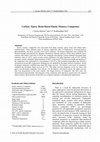Papers by CP Reghunadhan Nair
Journal of Polymer Materials, Dec 2, 2022
Journal of Macromolecular Science, Part A, 2003

Eurasian Chemico-Technological Journal, Nov 3, 2015
Effect of nanoclay modification on the properties of polytetramethylene oxide-based polyurethane ... more Effect of nanoclay modification on the properties of polytetramethylene oxide-based polyurethane was examined. Nanoclay was dispersed in polyurethane wherein the clay content was varied from 1 to 5 wt.%. The nanocomposites were characterized by thermal, FTIR, XRD and thermo-mechanical analyses and their shape memory properties were evaluated. Morphology was examined by TEM analysis. Bending test was adopted for the evaluation of shape memory property. Increase in clay content resulted an increase in transition temperature. Tensile strength and modulus increased proportional to nanoclay content. The elongation decreased with clay content. Intercalated structure of clay in the PU matrix was observed from XRD studies, which was confirmed by TEM analysis. Modulus ratio showed a decreasing trend with nanoclay content. This resulted in decreased shape recovery characteristics. Highest shape recovery of 92% was observed for PU with 1 wt.% clay content. Moderate nanoclay leveling is conducive to deriving mechanically stronger PU without loss of shape memory characteristics.

Polymers & Polymer Composites, Sep 1, 2008
The ternary matrix system comprising a reactive blend of epoxy, diallylbisphenol A, and bisphenol... more The ternary matrix system comprising a reactive blend of epoxy, diallylbisphenol A, and bisphenol A bismaleimide (EPB) was found to be comparable with the epoxy–phenol (EP) system in terms of its mechanical properties, and superior to it in terms of its high-temperature performance. The influence of structural variations of the epoxy resin on the thermal, physical, and mechanical properties of the ternary blend was examined. EPB compositions were prepared using a combination of bisphenol A bismaleimide and diallylbisphenol A with three different epoxy resin systems, namely novolac epoxy (E1), bisphenol A diglycidyl ether (E2), and tris(4-glycidyloxyphenyl)methane (E3). Cure characterisation of these reactive blends (EPB–E1, EPB–E2 and EPB–E3) was carried out using IR spectroscopy, differential scanning calorimetry, and rheological analysis. The trend in their thermal stability, based on the temperature of the onset of decomposition, is EPB–E3 > EPB–E1 > EPB–E2. The mechanical properties – compressive, flexural, and interlaminar shear strength – of the glass composites of these matrices were found to depend on the epoxy structure. The higher crosslink density of the trifunctional epoxy improved the high-temperature properties of the system. The ternary system served as a very good adhesive, where its strength as well as its retention at high temperature increased in proportion to the functionality of the resin. In general, the maximum strength values were observed for the system containing the novolac epoxy.

Polymers & Polymer Composites, 2004
Cyclomatrix phosphazene-triazine polymers were synthesized by co-curing a blend of tris (2-allylp... more Cyclomatrix phosphazene-triazine polymers were synthesized by co-curing a blend of tris (2-allylphenoxy) triphenoxy cyclotriphosphazene (TAP) and tris (2-allylphenoxy) s-triazine (TAT) with bis-(4-maleimido phenyl) methane (BMM). The co-curing of the three component resin was investigated by dynamic mechanical analysis using rheometry. The cured polymers with a phosphazene-triazine ratio of one and varying BMI-content were evaluated for their physical, thermal and mechanical properties. Tensile strength tended to decrease and the modulus increased with a corresponding decrease in elongation on enhancing the maleimide-content. The tensile properties were better for a composition with an allyl/maleimide ratio of two. Dynamic mechanical analyses implied a continuous modulus decrease with rise in temperature. The temperature of onset of thermal degradation and Tg of the cured polymers increased in proportion to the maleimide–content. Phosphazene and triazine were conducive to a reduction in the rate of thermal erosion at high temperatures.

Eurasian Chemico-Technological Journal, May 23, 2012
Elastic memory composites were processed from shape memory epoxy resins and carbon fabric reinfor... more Elastic memory composites were processed from shape memory epoxy resins and carbon fabric reinforcements. Three different types of epoxies (diglycidyl ether of bisphenol-A, tris(4-glycidyloxy phenyl)methane, and epoxy novolac) were used as matrices. Developed composites were evaluated for flexural strength and analyzed by Dynamic Mechanical Thermal analysis. Of the three different epoxy systems with carbon: resin ratio of 50:50, the composite with diepoxy system exhibited maximum glass transition value of 119°C, epoxy novalac system exhibited a low glass transition value of 54°C and the tris epoxy system exhibited a glass transition of 100°C respectively. The flexural strength and modulus of the composites were optimised at a concentration of 40 wt.%. The transition temperature also showed a maximum at around this composition. Bending test was adopted for the shape memory evaluation. All the developed composites exhibited more than 90% shape recovery. The diepoxy resin series of composites exhibited the maximum shape recovery of 97%. The shape recovery properties of the tris epoxy and epoxy novolac-based composites were inferior. For the diepoxy resin-based system, the shape recovery time was proportional to the resin content. The shape recovery of composite with 80% resin was demonstrated experimentally. The properties of the composites show that these systems have the required elastic memory characteristics for possible use in thermo-responsive self-deployable applications.

Polymers & Polymer Composites, Oct 1, 2003
Reactive blends of 2, 2'-diallyl bisphenol A (DABA) and a novolac epoxy resin (EPN) were investig... more Reactive blends of 2, 2'-diallyl bisphenol A (DABA) and a novolac epoxy resin (EPN) were investigated for their cure behaviour, and their rheological, physical, mechanical and thermal properties. Cure characterisation was by differential scanning calorimetry (DSC) and dynamic mechanical analysis (DMA). The system underwent dual curing through a sequential phenol-epoxy reaction and allyl polymerisation. The former reaction was catalysed by triphenyl phosphine (TPP). Whereas the phenol-epoxy reaction was completed, the allyl polymerization was limited to 40% by the regulation of cure conditions. Increase of epoxy concentration in DABA-EPN blends led to an improvement in the tensile strength and flexural strength of the neat castings. The flexural strength and interlaminar shear strength of the glass laminate showed an improvement with an increase in EPN concentration. Although the crosslink density of the neat casting was enhanced by epoxy-concentration, this did not result in any significant variations in the glass transition temperature (T g ) of the cured matrix. The T g was in the range 78-82°C. Complete polymerization of all allyl groups resulted in an increase in the T g and thermal stability while the mechanical properties of the neat system remained practically unaltered. The dual curing of the matrix system resulted in considerable improvement in the flexural properties of their glass composites.
Materials Letters, Dec 1, 2014
ABSTRACT A new shape memory polymer was synthesized by Huisgen 1, 3 dipolar polycycloaddition in ... more ABSTRACT A new shape memory polymer was synthesized by Huisgen 1, 3 dipolar polycycloaddition in the absence of solvents. The monomers, namely, 2,2′ (4,4′bispropargylbiphenol) perfluropropane and bisphenol A (bisazidohydroxy propyl) ether, were synthesized and characterized by FTIR, 1H and 13C NMR spectroscopies. The polyaddition resulting in polytriazole was performed at 140 °C. The elastic memory carbon composite of the resultant linear polymer possessed transition temperature of 113 °C and exhibited good shape recovery (95%) and shape retention (99%) properties. The polymer is thermally stable up to 275 °C.
Journal of materials chemistry. A, Materials for energy and sustainability, 2014

Journal of Applied Polymer Science, 2007
Novolac epoxy (EPN)-2,2 0 -diallyl bisphenol A (DABA) resin system was modified by cocuring it wi... more Novolac epoxy (EPN)-2,2 0 -diallyl bisphenol A (DABA) resin system was modified by cocuring it with bisphenol A bismaleimide (BMI). Molar concentration of BMI in the stochiometric blend of EPN and DABA was varied from 0.5 to 2.0. The cure optimization was done using DSC, IR spectroscopy, and rheological studies. The curing proceeded by phenol-epoxy and Alder-ene reactions. The performance of the ternary Epoxy-Allyl phenolic-Bismaleimide system was evaluated through their thermal and dynamic mechanical characterization. BMI improved the overall thermal stability and the modulus of the result-ant composites. The increase in BMI concentration in the system resulted in enhanced glass transition temperature with a consequent improvement in high temperature performance typically estimated by their lap shear strength at high temperatures. The high temperature performance of the epoxy-phenol-bismaleimide (EPB) system was found to be far superior to the epoxy-phenol (EP)system.

Journal of Materials Science, May 18, 2007
Polymer gels of poly(acrylic acid-co-acrylonitrile) [p(AA-co-AN)] of varying compositions were sy... more Polymer gels of poly(acrylic acid-co-acrylonitrile) [p(AA-co-AN)] of varying compositions were synthesized and complexed with polytetramethylene oxide (PTMO) to get PTMO/p(AA-co-AN) complexed gels. The complexation occurred through H-bonding of carboxyl group of acrylic acid with ether group of PTMO. The PTMO/p(AA-co-AN) gels were characterized by DSC, DMTA and swelling ratio. Their shape memory property was evaluated by bending tests. The swelling ratio of [p(AA-co-AN)] in PTMO (as solvent) increased and T g of the complexed gel diminished with enhancement in the acrylic acid-content in the copolymer. The modulus ratio (E g /E r ) increased with the acrylic acid content, which is conducive to better shape memory and shape recovery properties of the gels. The influence of the copolymer composition on the swelling ratio, T g, dynamic mechanical and the shape memory properties of the complexes is examined and presented. The gels showed a shape recovery of >90%, which increased with the acrylic acid content in the copolymer.

Journal of Applied Polymer Science, 2008
Syntactic foams of polybenzoxazine, containing moderately high volume percentage of glass microba... more Syntactic foams of polybenzoxazine, containing moderately high volume percentage of glass microballoons, were prepared. The specific gravity decreased with increase in microballoon content. The disproportionate decrease in specific gravity was ascribed to entrapment of air voids during compaction. The high content of microballoon increased the possibility for air voids that tended to get accumulated. The effect of microballoon concentration on tensile, compressive, and flexural strengths of the foams was studied. Tensile and compressive properties were optimized at about 68% by volume of microballoon while flexural strength decreased marginally on increasing the microballoon content. Althought the specific tensile and compressive strength showed a maximum followed by a decrease, the specific flexural strength systematically increased with microballoon content. The increased packing density of syntactic foam of a given constituent composition increased the compressive strength. The property variation was corroborated by morphological features, as evidenced in scanning electron micrographs. The syntactic foams showed ''multiple resin-neck formation'' and ''disc-shaped microballoon regions.'' The crushing of microballoons during molding was inevitable when compaction was effected to achieve a density beyond the theoretical one. Low-density syntactic foams tend to fail at lower loads because of fracturing of microballoons.
European Polymer Journal, Feb 1, 1999
Bis propargyl ethers of bisphenol-A, (BPA), bisphenol ketone (BPK) and bisphenol sulfone (BPS) we... more Bis propargyl ethers of bisphenol-A, (BPA), bisphenol ketone (BPK) and bisphenol sulfone (BPS) were synthesised and characterised. These monomers were thermally polymerised to the corresponding poly (bischromenes). The cure behaviour, as monitored by differential scanning calorimetry, depended on the structure of the monomer. The non isothermal kinetic analysis of the cure reaction using four integral methods revealed that the presence
Thermochimica Acta, Jul 1, 2001
Tris(2-allylphenoxy)triphenoxycyclotriphosphazene was reacted with three bismaleimides (BMI), viz... more Tris(2-allylphenoxy)triphenoxycyclotriphosphazene was reacted with three bismaleimides (BMI), viz. bis(4-maleimido phenyl)methane (BMM), bis(4-maleimido phenyl)ether (BME) and bis(4-maleimido phenyl)sulphone (BMS) via the Alder-ene reaction. The differential scanning calorimetric analysis of the blend manifested two distinct exotherms. The low temperature exothermic reaction was attributed to the Wagner-Jauregg reaction following the ene reaction and the strong exotherms at around 250–270°C to the cross-linking Diels–Alder
Journal of Polymer Science Part A, Mar 1, 1995
Cardanol incorporated-phenol-formaldehyde novolac resins were synthesized by acid and base cataly... more Cardanol incorporated-phenol-formaldehyde novolac resins were synthesized by acid and base catalyzed reactions. The novolacs were transformed to their cyanate esters. The thermal cure characteristics of the cyanate esters depended upon the composition. The presence of cardanol proportionately facilitated the curing. The thermal characterization of the novolacs and the corresponding cured phenolic-triazine networks indicated a dedicated a detremental effect of cardanol on the thermal stability and char residue of the resins.

Materials Today: Proceedings, 2020
Pentaerythritoltetranitrate (PETN), Cyclotrimethylenetrinitramine (RDX), Cyclotetramethylenetetra... more Pentaerythritoltetranitrate (PETN), Cyclotrimethylenetrinitramine (RDX), Cyclotetramethylenetetranitramine (HMX) are important high explosives used in a variety of military and industrial formulations. The present work investigates the interaction Ammonium Perchlorate with RDX, HMX and PETN and the effect of the interaction on the thermal decomposition of Ammonium Perchlorate. The microencapsulation of modified AP crystal was done with Viton. Thermogravimetry (TG) and Differential Scanning Calorimetry (DSC) were used to investigate the thermal properties and heat of decomposition. Kinetic analysis was done by Flynn Wall Ozawa (FWO) method. Scanning Electron Microscopy (SEM) was used to study the surface morphology of modified AP. The decomposition products were analysed by TG-MS. The presence of RDX/HMX/PETN or its decomposition products appears to catalyse the decomposition of AP.

Ammonium perchlorate (AP) is the universal oxidiser in use for all the solid rocket propellant mo... more Ammonium perchlorate (AP) is the universal oxidiser in use for all the solid rocket propellant motors used for space exploration due to its high available oxygen content and thermal decomposition without any solid residue. The inclusion of reactive species in AP directly affect the viscoelastic and ballistic properties of the propellant. Variations in lattice configuration of AP change its physical and thermal characteristics dramatically. In the present work AP was doped with Copper perchlorate and Iron perchlorate through co crystallisation. The impact of inclusion of these ionic species in the lattice on the thermal decomposition characteristics of AP was examined. The incorporation affected the physical as well as the ballistic characteristics of the resultant AP. The incorporation of foreign ions into AP crystals significantly changed the crystal morphology. The decomposition temperature decreased visa -vis with normal AP. The activation energy remarkably decreased for the doped AP crystals.
American Chemical Society. Abstracts of Papers (at the National Meeting), 1996
Journal of Applied Polymer Science, 2006
A binol ester initiator was used as a bifunctional ATRP initiator in combination with PMDETA/copp... more A binol ester initiator was used as a bifunctional ATRP initiator in combination with PMDETA/copper bromide catalyst system in DMF to synthesize n-butyl acrylate macroinitiator at 508C. The resulting macroinitiator was used for a detailed investigation of the ATRP of methyl methacrylate (MMA) with CuCl/N,N,N 0 ,N 0 ,N 00-pentamethyldiethylenetriamine (PMDETA) catalyst system in anisole at 308C. Thus, the MMA polymerization is shown to proceed with first order kinetics, with predicted molecular weight and narrow polydispersity indices. Gel permeation chromatography (GPC) and NMR were used for the characterization of the polymers synthesized.

Journal of Polymer Research, Sep 10, 2020
This paper deals with a study on toughening of an unsaturated polyester resin (UPR) using maleimi... more This paper deals with a study on toughening of an unsaturated polyester resin (UPR) using maleimide end-capped oligomers of polypropylene glycol (M-PPG), polytetramethyene oxide (M-PTMO), and polyethylene glycol (M-PEG) of varying molecular weights. These macro bismaleimides with large spacing between the functional groups were synthesized from the corresponding polyols (hydroxy telechelics) by reaction with (4-Maleimido) benzoyl chloride (MBC). These derivatives were characterised by chemical and spectral methods. These were then blended and co-cured with a UP resin based on copoly-propylene glycol (terephthalate-maleate) and relying on maleic acid-styrene copolymerisation for curing. The impacts of the nature, concentration and molecular weight of the telechelic additive on the physical and mechanical properties of the resultant unsaturated polyester resin (UPR) blends have been examined. Addition of the telechelics improved the mechanical characteristics of the crosslinked systems significantly. The improvement in fracture properties for a telecheilc was directly correlatable to a decrease in overall crosslink density estimated exprimentally as well as theoretically. The additive's backbone structure dictated the Tg and related properties of the blend. The properties were found to be the best for the blend toughened with M-PPG with a molecular weight 2000 g/mol, at 2.5 parts per hundred parts.The morphological features at this concentration as reflected in scanning electron microscopic analyses showed descrete poly ether particles microphase separation in the UPR matrix that acted as a crack path arrester.











Uploads
Papers by CP Reghunadhan Nair